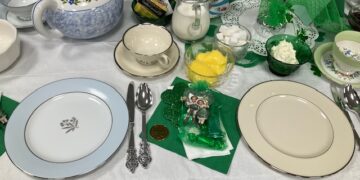
Mistletoe grows all over the northern hemisphere, but the most common and familiar variety in the United States is aptly named American Mistletoe, with the scientific name Phoradendron which means “thief of the tree” because unlike a majority of plants, mistletoe does not grow from the ground. It is a parasite, loving the woody boughs of most deciduous trees. The mistletoe’s naturally sticky seeds attach themselves to birds who feast on them and are then dispersed to other trees when the birds move to a new perch. There they hook into their host tree to siphon nutrients while also performing its own photosynthesis. They can grow up to 2-5 feet wide and have been called witches brooms by some folks, and the Navajo refer to it as “basket on high” because of its appearance high up in the tree.
The common name mistletoe has a fun origin. It is derived from early observations that the plant appears where birds have left their droppings. “Mistel” in Anglo Saxon means “dung” and “tan” means “twig” giving the full name the meaning “dung-on-a-twig” despite the arrival of mistletoe not being directly from bird droppings but rather the presence of the birds themselves as previously noted. There are several species of birds that subsist on mistletoe and also use the bushy plant as a nest. Some of the most common are robins, grouse, mourning doves, bluebirds, and even pigeons. Three American butterfly species also make mistletoe their only home, they are the great purple hairstreak, the thicket hairstreak and the Johnson hairstreak. Mistletoe also serves as some of the first pollen for bees and other pollinators in the spring, making it an important part of the ecosystem despite being parasitic in nature. While toxic to humans, a lot of small mammals like squirrels and chipmunks eat the seeds of mistletoe for an extra addition of protein to their diet.
Everyone is likely familiar with the idea that if you meet up with someone underneath a sprig of mistletoe you must then kiss. That is a tradition that dates way back to the early Norse days when mistletoe was seen as a symbol of fertility. The Norse folks also saw mistletoe as a plant that promoted peace. If two enemies found themselves underneath a mistletoe plant, it was expected for them to stop fighting for at least a day. Ancient civilizations have also traditionally used it medicinally for its healing properties. Ancient Greeks used it for many things from menstruation issues to spleen troubles. Druids believed that mistletoe provided protection from all evil and put fresh sprigs above their doorways at the beginning of each new year, clearing out the old ones that protected the family from evil throughout the year.
There are a lot of other really neat mistletoe facts and folklore stories available to read online. I recommend curling up with your favorite blanket and warm beverage and reading more about this fascinating plant. When you’re out and about in the forest at this time of year, look up! You may see some mistletoe right above your head.
































